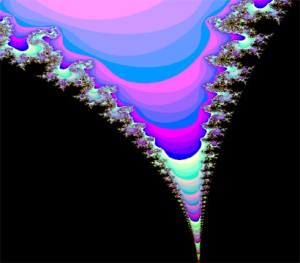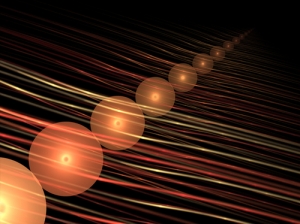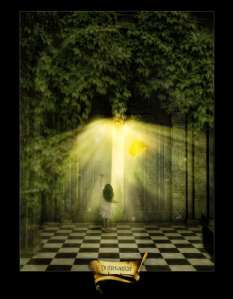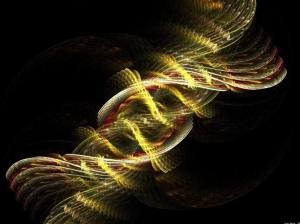I am not a great believer in words..but I guess the more people believe in words the more powerful they can be.. (thank you Mona K). I came across these words in my twitter stream just as I pondered Jung’s imaginal encounter with “the Anchorite” in the Red Book (RB), in which the two of them discuss the meaning of words.
We are shaped by the spoken and, to even a greater degree, by the written word.

The Anchorite (an inner, imaginal figure) speaks to Jung: “Surely you know that one can read a book many times – perhaps you almost know it by heart, and nevertheless it can be that, when you look again at the lines before you, certain things appear new or even new thoughts occur to you that you did not have before”.
What is suggested here is to appreciate the “word” as a symbol and not as a sign with a definitive, unmovable meaning. A symbol is a door into the unknown and language, the word, can be such a portal. We all the know the power of poetry or of a book that transported us into another world. A good piece of writing can take us to very unexpected places, if we allow it to happen. “A succession of words does not have only one meaning. But men strive to assign only a single meaning to the sequence of words, in order to have unambiguous language”, the Anchorite proclaims.
Like a tightrope walker we are asked to perform a delicate balancing act. Words and language allow us to grasp and assimilate the nature of reality. It is hard to detach the word from human consciousness. “What was word, shall become man. The word created the world and came before the world. It lit up like a light in the darkness“, Jung writes. He also says that “this striving is worldly and constricted” and the mysterious addition that this striving “belongs to the deepest layers of the divine creative plan”.
Words and language allow us to grasp and assimilate the nature of reality. It is hard to detach the word from human consciousness. “What was word, shall become man. The word created the world and came before the world. It lit up like a light in the darkness“, Jung writes. He also says that “this striving is worldly and constricted” and the mysterious addition that this striving “belongs to the deepest layers of the divine creative plan”.
Initially the limited, narrow range of meaning provides security. We need to believe the illusion that we know what is what. Jung writes, “the unbounded makes you anxious since the unbounded is fearful and humanity rebels against it”.
The paradox: We must build walls of meaning in order to emerge as conscious beings out of the chaos, but then these very walls must be broken down, because “words should not become Gods”.
One way of measuring ego-strength and maturity of personality is to assess a person’s capacity to tolerate ambivalence. This capacity is closely related to the ability to feel empathy. It is all about tolerating otherness. Empathy is the genuine ability to see the world through the eyes of another. Another who is truly different, someone who cannot be easily understood. It takes effort (and ego-strength) to make room for another standpoint, another meaning. There are many ways to be right. We have reached maturity when we can give up tour need to be right without losing ourselves and our values.
Imagine ~ making room ~ imagine that the entire universe is within you and every person, every other living creature is a parallel universe ~ no either/or, no right or wrong
“He who breaks the walls of words overthrows Gods and defiles temples”, Jung writes. We need to break down the prison of stale and empty words. We need to dismantle inherited belief systems, which have lost the spark of life. We need to give up the delusion that a word in itself represents truth. It does not matter whether the word is in the Bible or in another writing considered sacred, in your favorite novel, on the internet or in one of our ingrained thought patterns. The word may give us temporary security. That may be necessary for some time. But the evolution of consciousness cannot be stopped, it can only be resisted, which makes it harder. The evolutionary trajectory of life pushes us towards new meaning. Meaning full of juicy freshness and uniquely individual. This is what Jung’s entire life’s work was about. But this encouragement comes with a warning. Jung writes: “But no one should shatter the old words, unless he finds the new word that is a firm rampart against the limitless and grasps more life in it than in the old word”. We find this over and over again in Jung’s work. Jung who parted ways with Freud, because he believed that the unconscious did not only need to be tamed, but was also the source of rejuvenation and great treasures, was also acutely aware that its forces were so powerful that it could sweep us into the chaos of psychosis at any time.
The word is a container and a prison. We need to find the balance on the tightrope. Words, stories, narratives create our lives. As we grow, our stories, memories and narratives can change. Are our narratives, the way we think about ourselves still true? Are they still meaningful in the sense that light and life are pulsating through them? Or do they need to be shed like a serpent leaves its old skin behind? Nothing is forever. We are always becoming.
Nothing is forever. We are always becoming.
Posted in
C.G. Jung, Jungian Psychology,Tags:
Analytical psychology,
C.G. Jung,
consciousness,
Depth Psychology,
Jungian psychology,
Jungian thought,
meaning,
narrative,
psychosis,
renewal,
symbol,
The Red Book,
The Word,
thought patterns,
unconscious,
unknown,
word
In 1925, in the midst of working on the Red Book (RB) Jung wrote “It seemed to me I was living in an insane asylum of my own making. I went about with all these fantastic creatures: centaurs, nymphs, satyrs, gods and goddesses as though they were patients and I was analyzing them”.
 S. Shamdasani, the editor of the RB, noted that Jung found mythological work both exciting and intoxicating. Jung understood mythological images as symbols of the universal life force (libido) depicting the movements and dynamics of the autonomous, archetypal psyche.
S. Shamdasani, the editor of the RB, noted that Jung found mythological work both exciting and intoxicating. Jung understood mythological images as symbols of the universal life force (libido) depicting the movements and dynamics of the autonomous, archetypal psyche.
Jung writes about one of his earlier visions: “On the night when I considered the essence of the God, I became aware of an image.” In this vision he dialogues with Elijah and his daughter Salome. Two thoughts strike me immediately as relevant for an understanding of Jung’s approach. One is his use of the word image.
An image is not to be confused with outer reality. Physicists provide explanations for the nature of matter and outer reality, but one thing is certain, our experience creates an inner image that is not the same as outer reality. The image is a subjective experience in the individual mind. It can be visual, but the experience of a sound or a physical sensation will also bring forth an image. A thought is an image. No question, there is an outer world and also an objective psychic reality, but it is only through the subjective capacity of cultivated self-reflection that one can – with some luck and grace – gain access and insight into the larger, transpersonal realities. An image is like a symbol. It is not to be taken literally or the door becomes a trap holding you prisoner in a concrete and narrow reality. An image is a doorway  into another reality. A paradoxical situation, the image is you and is not you. You are the observer and the observed. A necessary duality has been created. Necessary because all creation depends on this duality and the forever shifting dance between the two opposing forces. A oneness has been torn asunder. It is in the liminal space in-between that new life can be born. In the context of self-reflection the new life can be a new insight, the possibility of a new pattern of experience.
into another reality. A paradoxical situation, the image is you and is not you. You are the observer and the observed. A necessary duality has been created. Necessary because all creation depends on this duality and the forever shifting dance between the two opposing forces. A oneness has been torn asunder. It is in the liminal space in-between that new life can be born. In the context of self-reflection the new life can be a new insight, the possibility of a new pattern of experience.
In the context of a necessary duality, it is interesting that Jung when contemplating the essence of “the God”, encountered a male AND a female figure. The transpersonal may be a field of oneness, but the human intellect can only approximate the divine mystery of creation as two intertwined forces. As above so below. Think DNA. These two opposing forces are often referred to as masculine and feminine, but one must drop all preconceived notions about gender or sexuality. Each individual psyche, male or female, is made up of these energy strands, as is the objective, archetypal psyche. Yang and Yin are more neutral descriptions. Jung elicited the principles of Logos (yang, masculine, foresight, legislation, ordering, willful) and Eros (yin, feminine, receptive, related, moving, dissolving) out of his visionary meeting with Elijah and Salome. Jung writes: The way of life writhes like a serpent from right to left, from thinking to pleasure and from pleasure to thinking. Collectively and individually we are suffering an imbalance in this eternal dance that has favored the masculine principle. Where Logos rules order and persistence prevail, where Logos rules at the expense of Eros, it degenerates into dominance and abuse of power. In the individual this tendency can be associated to the sickness of the soul, known as the narcissistic personality. The problem of narcissism has been thought of as a characteristic of a dying culture. I can see this trajectory, unless psyche is irrigated by the flow of eros and balance is restored one more time again.
These two opposing forces are often referred to as masculine and feminine, but one must drop all preconceived notions about gender or sexuality. Each individual psyche, male or female, is made up of these energy strands, as is the objective, archetypal psyche. Yang and Yin are more neutral descriptions. Jung elicited the principles of Logos (yang, masculine, foresight, legislation, ordering, willful) and Eros (yin, feminine, receptive, related, moving, dissolving) out of his visionary meeting with Elijah and Salome. Jung writes: The way of life writhes like a serpent from right to left, from thinking to pleasure and from pleasure to thinking. Collectively and individually we are suffering an imbalance in this eternal dance that has favored the masculine principle. Where Logos rules order and persistence prevail, where Logos rules at the expense of Eros, it degenerates into dominance and abuse of power. In the individual this tendency can be associated to the sickness of the soul, known as the narcissistic personality. The problem of narcissism has been thought of as a characteristic of a dying culture. I can see this trajectory, unless psyche is irrigated by the flow of eros and balance is restored one more time again.
I am less interested in why Jung’s psyche chose Elijah and Salome as personifications of his unconscious thoughts. These are uniquely his images. It seems of much greater significance how he engaged these images. A method that later became known as Active Imagination. A technique that strongly emphasizes the duality principle. In other words, the ego, the “I” as I know it does not disappear in the face of the visionary figure. One must hold ones ground vis-a-vis an imaginative figure. They are to be met with respect, but not revered as gods, because they are not. Nor are imaginative figures spirits who have all the answers and will tell one what to do. They also don’t foretell the future. Our psychic images are real, but the essence of their reality is behind the surface of the mental image.
It is in this dialogue with Elijah and Salome, in that sacred, liminal space between them that Jung realizes: “If forethinking and pleasure unite in me, a third arises from them, the divine son, who is the supreme meaning, the symbol, the passing over into a new creation. I do not myself become the supreme meaning or the symbol, but the symbol becomes in me such that it has its substance, and I mine.”
Not one, not two. The paradox, nonduality requires duality.
Posted in
C.G. Jung, Jungian Psychology,Tags:
active imagination,
Analytical psychology,
C.G. Jung,
creation,
creative process,
creativity,
Depth Psychology,
divine,
duality,
eros,
god,
image,
imagination,
Jungian psychology,
logos,
mystery,
narcissism,
psyche,
renewal,
soul,
The Red Book,
transpersonal,
yang,
yin
Much has been written about the film Avatar since its release. Critical voices abound. Some see it as a “white person’s fantasy on racial identity”. This thought would have never occurred to me. Others see it as a “mythic expose” of Western militarism & colonialism. That reasoning I can appreciate. It is what one might see when the eye is focused on the history of Western civilization. To that I will add some thoughts from psyche’s perspective.
I will focus on the intra-psychic angle, which means we will attempt to see from “the inside out”. Imagine that there is indeed a World Soul, as the ancient philosphers and alchemists believed and captured in the image of the Anima Mundi (Soul of the world). It is the spirit in nature that animates all matter. It is the spirit that creates an interconnected, sentient and intelligent web of life of which humanity is part of.
An ancient symbol of this unity of life is the world tree. This image shows up in most world mythologies. From Yggrasil, the world tree in Nordic mytholgy to the Tree of Life in the Genesis. It is part of the mythology of the San people of the Kalahari desert, the oldest existing culture on earth and the world tree also figures prominently in the cosmology of the Mayans. That so many seemingly unrelated cultures revere the world tree points towards a synchronistic event reflecting a much larger cosmic reality. As above so below.
The biologist Carl Calleman postulates (in “The Purposeful Universe”), a central axis, a cosmic Tree of Life which creates organizations of life on a microcosmic level, that is on the level of our lived life. The soul knows, and has always known, that the image of the tree holds a deep mystery and a connection to a transpersonal reality. The tree, deeply rooted in the ground below, opens its branches towards the heavens. It needs the water from below and the light from above to live and grow. In Jungian thought, the tree, has a bridging function and is an integral part of nature. The tree image is an exquisite image of the archetypal feminine.
Such a tree is the source of strength, knowledge and inspiration of the Na’vi, the native inhabitants of Pandora. I suggest that the Na’vi can be seen as personifications of our disowned and split off connection to nature, our own nature as well as Nature in the world. The Na’vi may represent our repressed connection to the mysteries and wonders of life and cosmic reality. This seems true on an individual as well collective level. On the individual level, this is what happens when cynicism wins out over a tender feeling. In that moment a bulldozer killing machine steamrolls our soul and consciousness. Not unlike the military commander, who is cut off from nature’s suffering and her plight. The abuse of the natural world and her resources on a collective level are so blatantly obvious that there is no need to go into further detail now.
Avatar can be seen as a constructive countervision to the catastrophy mongering of 2012 mania. It shows us what needs to be done. Individually and collectively. The archetypal feminine is returning. Whether we like or not, the Goddess is on her way back. Symbolically,not literally, but the forces involved are VERY REAL. Whether this will be a smooth process or a catastrophic event depends largely on us. Can we make this shift, as individuals and as a culture, to make room for Yin, the archetypal feminine and expand our linear, mechanistic and overly rational frame of what we think consciousness is?
One intriguing fact is that the Na’vi are blue. I have no doubt the makers of Avatar were aware of the blue god in Hindu mythology, Krishna. Krishna was the eighth reincarnation (avatar) of the Hindu God Vishnu. Significant similarities exist between Krishna and the Christ figure. Both were sent by a father god to challenge the tyranny of the ruling class. Both were considered divine and human. Krishna is often depicted with a flute, which people found irresistable. Krishna was a rebel, a poet and a lover of many women in Hindu lore. This earthy behavior and the flute connect him to the Greek Pan and they are all aspects of the connection to the archetypal feminine that needed to be split off, denied and repressed in the Christ of the dogmatic church. (Only the Gnostics allowed for a different image of Christ to surface).
Krishna was the eighth reincarnation (avatar) of the Hindu God Vishnu. Significant similarities exist between Krishna and the Christ figure. Both were sent by a father god to challenge the tyranny of the ruling class. Both were considered divine and human. Krishna is often depicted with a flute, which people found irresistable. Krishna was a rebel, a poet and a lover of many women in Hindu lore. This earthy behavior and the flute connect him to the Greek Pan and they are all aspects of the connection to the archetypal feminine that needed to be split off, denied and repressed in the Christ of the dogmatic church. (Only the Gnostics allowed for a different image of Christ to surface).
The 2012 hype aside, many sense that a major shift is demanded from us. We may need to, as shown in AVATAR, emerge into our Na’vi nature, which is living in harmony with the feminine of which the soul is part of. This is not a simplistic return to nature or to a previous evolutionary stage. It may be the next leap in the evolution of consciousness, and the only one that may hold the promise of survival.
Posted in
Life with a Jungian twistTags:
2012,
anima mundi,
archetypal feminine,
Avatar,
Avatar the movie,
C.G. Jung,
Carl Calleman,
collective unconscious,
consciousness,
Depth Psychology,
Hindu Mythology,
Jungian psychology,
Krishna,
movies,
psyche,
renewal,
soul,
spirit,
Spirituality,
tree of life,
world soul,
world tree,
Yggrasil,
yin
Jung’s Red Book (RB) is a book of extraordinary beauty. Nothing got lost in the reproduction. While I focus here primarily on the images of ideas in the text, it is a treat to spend time with Jung’s paintings, the details of the calligraphic script of the Liber Primus in its medieval manuscript form. Wherever you can, take the chance to take a look at the book! I hope I will eventually find a way of bringing some of the images in here, without infringing on any copyrights. I can read the original in German, which I do in bits and pieces, but it is hard work to decipher Jung’s calligraphic longhand. For the most part I resort to the English translation, which, as far as I can tell, is a brilliant one.
But let me begin at the beginning. The way of what is to come is the heading of the first section of the Liber Primus. Jung speaks “in the spirit of the time”. Each time, each era has a specific “spirit”, a Zeitgeist, that forms our rational mind, morals and values. We are good citizens if we act in accordance to this spirit of the time. The spirit of the time forms our ego-personality and does not question the supremacy of God in the spiritual realm.
But then Jung also speaks of the spirit of the depths that has begun to stir in him. A spirit that “from time immemorial and for all the future possesses a greater power than the spirit if this time” p.229. It was this spirit, irrational, foolish, intoxicating, even ugly (at least from the other spirit’s point of view) that was the motivating, even dictating force behind the RB. Here Jung seems to talk about the spirit of the greater archetypal psyche. A potentially dangerous force if one is possessed by it. Madness, insanity and psychosis loom if this spirit takes over. But this very same spirit of the depths is also the source of all visions, inspiration and greatness and divine bliss that humanity can hope for. It is, in Jungian lingo, the spirit if the Self (with a capital S), which represents and brings forth the God-like nature in mankind, with all its dark and bright aspects.
Jung is a true shaman here. Never identified. Never possessed. Fully aware of the danger of a one way ticket into psychosis, he stays put and moves along where the spirit of the depths ushers him. He made sense of the nonsensical because a NEW VISION was needed. No pain, no gain. No risk, no gain.
Apropos, a new vision. There is a quote from “Flight out of time: A Dada diary” in the RB, which I will repeat here:
“The world and society in 1913 looked like this: life is completely confined and shackled. A kind of economic fatalism prevails; each individual, whether he resists it or not, is assigned a specific role and with it his interests and his character. The church is regarded as a “redemption factory” of little importance, literature is a safety valve……The most burning question day and night is: is there anywhere a force that is strong enough to put an end to this state of affairs? And if not, how can one escape it?”
Now that is a pretty neat quote. I have no problem putting 2009 instead of 1913. Are we not as much in need of a vision for cultural and spiritual renewal as the dadaists observed in 1913? Another question, is it not interesting that the RB is published at a time when we are desperately in need (think 2012!) of a new vision that leads to renewal. In fact our very survival may depend on that. Some might even call that a synchronicity.
Posted in
C.G. Jung, Jungian Psychology,Tags:
2012,
C.G. Jung,
consciousness,
dadaists,
Jungian psychology,
psychosis,
religion,
renewal,
shaman,
shamanism,
society,
Spirituality,
synchronicity,
The Red Book,
visions,
zeitgeist

 Words and language allow us to grasp and assimilate the nature of reality. It is hard to detach the word from human consciousness. “What was word, shall become man. The word created the world and came before the world. It lit up like a light in the darkness“, Jung writes. He also says that “this striving is worldly and constricted” and the mysterious addition that this striving “belongs to the deepest layers of the divine creative plan”.
Words and language allow us to grasp and assimilate the nature of reality. It is hard to detach the word from human consciousness. “What was word, shall become man. The word created the world and came before the world. It lit up like a light in the darkness“, Jung writes. He also says that “this striving is worldly and constricted” and the mysterious addition that this striving “belongs to the deepest layers of the divine creative plan”.

 Nothing is forever. We are always becoming.
Nothing is forever. We are always becoming.
 S. Shamdasani, the editor of the RB, noted that Jung found mythological work both exciting and intoxicating. Jung understood mythological images as symbols of the universal life force (libido) depicting the movements and dynamics of the autonomous, archetypal psyche.
S. Shamdasani, the editor of the RB, noted that Jung found mythological work both exciting and intoxicating. Jung understood mythological images as symbols of the universal life force (libido) depicting the movements and dynamics of the autonomous, archetypal psyche. into another reality. A paradoxical situation, the image is you and is not you. You are the observer and the observed. A necessary duality has been created. Necessary because all creation depends on this duality and the forever shifting dance between the two opposing forces. A oneness has been torn asunder. It is in the liminal space in-between that new life can be born. In the context of self-reflection the new life can be a new insight, the possibility of a new pattern of experience.
into another reality. A paradoxical situation, the image is you and is not you. You are the observer and the observed. A necessary duality has been created. Necessary because all creation depends on this duality and the forever shifting dance between the two opposing forces. A oneness has been torn asunder. It is in the liminal space in-between that new life can be born. In the context of self-reflection the new life can be a new insight, the possibility of a new pattern of experience. These two opposing forces are often referred to as masculine and feminine, but one must drop all preconceived notions about gender or sexuality. Each individual psyche, male or female, is made up of these energy strands, as is the objective, archetypal psyche. Yang and Yin are more neutral descriptions. Jung elicited the principles of Logos (yang, masculine, foresight, legislation, ordering, willful) and Eros (yin, feminine, receptive, related, moving, dissolving) out of his visionary meeting with Elijah and Salome. Jung writes: The way of life writhes like a serpent from right to left, from thinking to pleasure and from pleasure to thinking. Collectively and individually we are suffering an imbalance in this eternal dance that has favored the masculine principle. Where Logos rules order and persistence prevail, where Logos rules at the expense of Eros, it degenerates into dominance and abuse of power. In the individual this tendency can be associated to the sickness of the soul, known as the narcissistic personality. The problem of narcissism has been thought of as a characteristic of a dying culture. I can see this trajectory, unless psyche is irrigated by the flow of eros and balance is restored one more time again.
These two opposing forces are often referred to as masculine and feminine, but one must drop all preconceived notions about gender or sexuality. Each individual psyche, male or female, is made up of these energy strands, as is the objective, archetypal psyche. Yang and Yin are more neutral descriptions. Jung elicited the principles of Logos (yang, masculine, foresight, legislation, ordering, willful) and Eros (yin, feminine, receptive, related, moving, dissolving) out of his visionary meeting with Elijah and Salome. Jung writes: The way of life writhes like a serpent from right to left, from thinking to pleasure and from pleasure to thinking. Collectively and individually we are suffering an imbalance in this eternal dance that has favored the masculine principle. Where Logos rules order and persistence prevail, where Logos rules at the expense of Eros, it degenerates into dominance and abuse of power. In the individual this tendency can be associated to the sickness of the soul, known as the narcissistic personality. The problem of narcissism has been thought of as a characteristic of a dying culture. I can see this trajectory, unless psyche is irrigated by the flow of eros and balance is restored one more time again.

 Krishna was the eighth reincarnation (avatar) of the Hindu God Vishnu. Significant similarities exist between Krishna and the Christ figure. Both were sent by a father god to challenge the tyranny of the ruling class. Both were considered divine and human. Krishna is often depicted with a flute, which people found irresistable. Krishna was a rebel, a poet and a lover of many women in Hindu lore. This earthy behavior and the flute connect him to the Greek Pan and they are all aspects of the connection to the archetypal feminine that needed to be split off, denied and repressed in the Christ of the dogmatic church. (Only the Gnostics allowed for a different image of Christ to surface).
Krishna was the eighth reincarnation (avatar) of the Hindu God Vishnu. Significant similarities exist between Krishna and the Christ figure. Both were sent by a father god to challenge the tyranny of the ruling class. Both were considered divine and human. Krishna is often depicted with a flute, which people found irresistable. Krishna was a rebel, a poet and a lover of many women in Hindu lore. This earthy behavior and the flute connect him to the Greek Pan and they are all aspects of the connection to the archetypal feminine that needed to be split off, denied and repressed in the Christ of the dogmatic church. (Only the Gnostics allowed for a different image of Christ to surface).